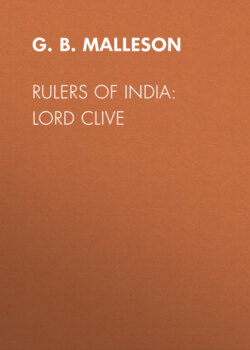Rulers of India: Lord Clive

Реклама. ООО «ЛитРес», ИНН: 7719571260.
Оглавление
G. B. Malleson. Rulers of India: Lord Clive
Rulers of India: Lord Clive
Table of Contents
PREFACE
LORD CLIVE
CHAPTER I
CHAPTER II
CHAPTER III
CHAPTER IV
CHAPTER V
CHAPTER VI
CHAPTER VII
CHAPTER VIII
CHAPTER IX
CHAPTER X
CHAPTER XI
CHAPTER XII
CHAPTER XIII
CHAPTER XIV
CHAPTER XV
INDEX
Отрывок из книги
G. B. Malleson
Published by Good Press, 2021
.....
Before I proceed to describe those events, it seems advisable to say a few words regarding the two settlements to which I have just referred; of the principles which actuated their chiefs; and of the causes which brought them into collision.
The English had made a first settlement on the Coromandel coast in the year 1625 at a small place, some thirty-six miles to the south of Madras, known now as Armagon. Seven years later they obtained from the Rájá of Bisnagar a small grant of land, called by the natives Chennapatanam from the village contained thereon. They re-named the place Madras, and built there a fort round their storehouses which they named Fort St. George. In 1653 the Company in London raised the agency at Madras to the position and rank of a Presidency. Towards the end of the seventeenth century the establishment there counted a population of 300,000 souls. In 1744 the town consisted of three divisions: that to the south (the White Town) extending about four hundred yards in length from north to south, and about one hundred yards in breadth. There resided the Europeans, mainly English. They had there about fifty houses, two churches, one of them Catholic; likewise the residence of the chief of the factory. All these were within the enclosure called Fort St. George. That somewhat pompous title represented merely a slender wall, defended by four bastions and as many batteries, very slight and defective in their construction, and with no outworks to defend them. This division was generally known as the 'White Town.' To the north of it, and contiguous, was another division, much larger and worse fortified, principally tenanted by Armenian and Indian merchants, called the Black Town. Beyond this, again to the north, was a suburb, where the poorer natives resided. These three divisions formed Madras. There were likewise to the south, about a mile distant from the White Town, two other large villages, inhabited solely by natives; but these were not included within that term. The English at this period did not exceed three hundred in number, and of these two-thirds were soldiers, but few of whom had seen a shot fired.2
.....